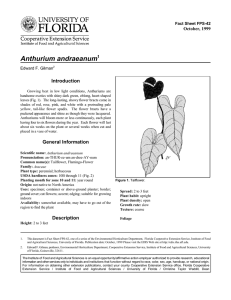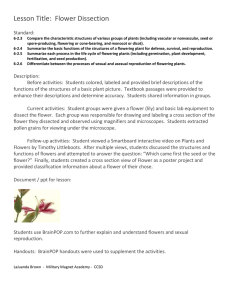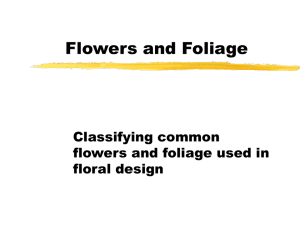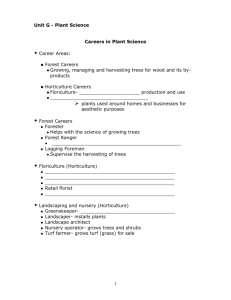S
advertisement
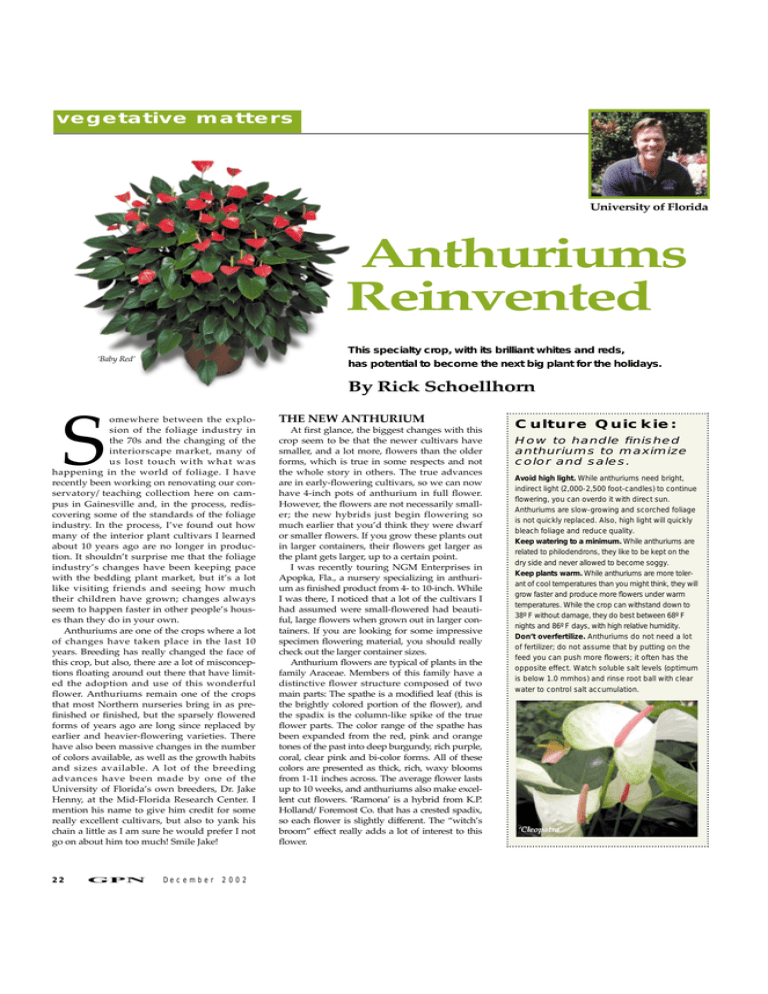
vegetative new varieties matters University of Florida Anthuriums Reinvented This specialty crop, with its brilliant whites and reds, ‘Baby Red’ has potential to become the next big plant for the holidays. By Rick Schoellhorn S omewhere between the explosion of the foliage industry in the 70s and the changing of the interiorscape market, many of us lost touch with what was happening in the world of foliage. I have recently been working on renovating our conservatory/teaching collection here on campus in Gainesville and, in the process, rediscovering some of the standards of the foliage industry. In the process, I’ve found out how many of the interior plant cultivars I learned about 10 years ago are no longer in production. It shouldn’t surprise me that the foliage industry’s changes have been keeping pace with the bedding plant market, but it’s a lot like visiting friends and seeing how much their children have grown; changes always seem to happen faster in other people’s houses than they do in your own. Anthuriums are one of the crops where a lot of changes have taken place in the last 10 years. Breeding has really changed the face of this crop, but also, there are a lot of misconceptions floating around out there that have limited the adoption and use of this wonderful flower. Anthuriums remain one of the crops that most Northern nurseries bring in as prefinished or finished, but the sparsely flowered forms of years ago are long since replaced by earlier and heavier-flowering varieties. There have also been massive changes in the number of colors available, as well as the growth habits and sizes available. A lot of the breeding advances have been made by one of the University of Florida’s own breeders, Dr. Jake Henny, at the Mid-Florida Research Center. I mention his name to give him credit for some really excellent cultivars, but also to yank his chain a little as I am sure he would prefer I not go on about him too much! Smile Jake! 22 GPN December 2002 THE NEW ANTHURIUM At first glance, the biggest changes with this crop seem to be that the newer cultivars have smaller, and a lot more, flowers than the older forms, which is true in some respects and not the whole story in others. The true advances are in early-flowering cultivars, so we can now have 4-inch pots of anthurium in full flower. However, the flowers are not necessarily smaller; the new hybrids just begin flowering so much earlier that you’d think they were dwarf or smaller flowers. If you grow these plants out in larger containers, their flowers get larger as the plant gets larger, up to a certain point. I was recently touring NGM Enterprises in Apopka, Fla., a nursery specializing in anthurium as finished product from 4- to 10-inch. While I was there, I noticed that a lot of the cultivars I had assumed were small-flowered had beautiful, large flowers when grown out in larger containers. If you are looking for some impressive specimen flowering material, you should really check out the larger container sizes. Anthurium flowers are typical of plants in the family Araceae. Members of this family have a distinctive flower structure composed of two main parts: The spathe is a modified leaf (this is the brightly colored portion of the flower), and the spadix is the column-like spike of the true flower parts. The color range of the spathe has been expanded from the red, pink and orange tones of the past into deep burgundy, rich purple, coral, clear pink and bi-color forms. All of these colors are presented as thick, rich, waxy blooms from 1-11 inches across. The average flower lasts up to 10 weeks, and anthuriums also make excellent cut flowers. ‘Ramona’ is a hybrid from K.P. Holland/Foremost Co. that has a crested spadix, so each flower is slightly different. The “witch’s broom” effect really adds a lot of interest to this flower. Culture Quickie: How to handle finished anthuriums to maximize color and sales. Avoid high light. While anthuriums need bright, indirect light (2,000-2,500 foot-candles) to continue flowering, you can overdo it with direct sun. Anthuriums are slow-growing and scorched foliage is not quickly replaced. Also, high light will quickly bleach foliage and reduce quality. Keep watering to a minimum. While anthuriums are related to philodendrons, they like to be kept on the dry side and never allowed to become soggy. Keep plants warm. While anthuriums are more tolerant of cool temperatures than you might think, they will grow faster and produce more flowers under warm temperatures. While the crop can withstand down to 38º F without damage, they do best between 68º F nights and 86º F days, with high relative humidity. Don’t overfertilize. Anthuriums do not need a lot of fertilizer; do not assume that by putting on the feed you can push more flowers; it often has the opposite effect. Watch soluble salt levels (optimum is below 1.0 mmhos) and rinse root ball with clear water to control salt accumulation. ‘Cleopatra’ vegetative matters new varieties Production of anthuriums is somewhat specialized. First of all, they are a slow crop, taking somewhere around nine months to produce a 6-inch pot from a 72-cell liner. It is due to this long production time that most Northern growers and florists ship-in finished material rather than growing their own plants. The very cleanest production facilities are essential throughout production, as small plants are susceptible to bacterial and fungal problems. Plants begin as tissue culture liners and are grown out as 4inch material. Plants are shifted to larger containers as they grow, so that last year’s 4-inch crop may be next year ’s 6- to 8-inch crop, depending on the vigor of the cultivar. ‘Sarah’ where to buy Most of the American distribution of tissue culture liners comes from the following companies, though others undoubtedly exist and provide excellent product. DEBUNKING THE MYTHS There are a number of misconceptions in the industry about what anthuriums need to perform at their best. While they are tropical and do need warmth and high humidity to flourish, here are some things they don’t need. Misconception #1. Anthuriums are low-light plants. The key to continued flowering is bright, indirect light. Yes, you want to avoid direct northern sun as it will scorch the foliage, but by the same token, don’t assume the plant needs to be kept in the dark. Lack of light is the major reason anthuriums stop flowering. Misconception #2. Anthuriums need lots of water. Keep these plants on the dry side; they like to dry out between watering. It has a lot to do with their thick, fleshy roots needing air and rotting if kept too wet. All in all, it is better to slightly under-water than to over-water. Anthuriums are not drought-tolerant, so don’t go overboard; leaf tips may scorch if plants become too dry. It is also not necessary to repot anthuriums as, in most cases, they prefer to be root-bound, and this helps to avoid over-watering. Misconception #3. Anthuriums need a lot of fertilizer. Anthuriums are actually pretty light feeders, needing only between 75-200 ppm nitrogen as a regular feeding. Try to stick with a 1:2:1 ratio fertilizer, and occasionally flush the soil with clear water to keep the soluble salt level low. SIZING ANTHURIUMS Anthuriums for 4-inch sales. Remember that most cultivars begin life as 4-inch pots before being shifted into larger pots. Therefore, most cultivars can be grown as small pots, but certain cultivars flower more vigorously in small pots than others. There is a new series out from Oglesby called ‘Small Talk’; bright colors and early flowering allow it be produced in 4-inch or larger pots. Anthuriums for 6-inch sales. Most current cultivars work well in a 6-inch pot, but some produce more flowers and offer more color than others. Here are a few to look for if you want 6-inch material. Try ‘Orange Hots’ and ‘Red Hots’ for a multi-flowered, bright, tropical effect; these are from the University of Florida’s ‘Miami Beauty’ Agristarts (407) 889-8055 www.agristarts.com Foremost Co. (800) 421-8986 www.foremostco.com ‘Anouke’ Milestone Agriculture (800) 215-2210 www.milestoneag.com Oglesby Plants International (800) 762-0022 www.oglesbytc.com Twyford Laboratories (800) 905-3263 www.twyford.com ‘Red Love’ Dr. Jake Henny’s breeding program. Also, check out ‘Anouke’ (Rijn/Milestone Agriculture) and ‘Ms. June’ (Agristarts) for rich purple tones. Twyford’s ‘Tropic Fire’ was a strong red, as is Agristarts’ ‘Miami Beauty’. Anthuriums for 8- to 10-inch sales. These are the cultivars for really outstanding, large flowers and dramatic foliage. While any of the above cultivars is likely available in larger pots, I really was impressed with Milestone Agriculture’s ‘Sarah’, with peach- and greenmottled blooms up to 12 inches across; ‘Cleopatra’ was a magnificent pure white with 6-inch blooms and deep green foliage; and ‘Red Love’ was also excellent with high contrast between the red and green portions of the flower. The flowers on these cultivars often age back into green tones, so they last longer on the plant and provide a very longlasting tropical color. As I had just begun my annual trip around the state of Florida to look at poinsettia crops, I couldn’t help but look at the brilliant red anthuriums and think the ultimate heresy… “Why can’t these plants also be used as holi- Check the Web or contact sales representatives from these companies if you are looking for quality pre-finished or finished product producers. day items?” The white forms are stately, the colored types are vivid, and they last many months instead of weeks. All of this not only tells you this is a good upper-end crop but that we can probably expect to see more of this plant in the future. Just as orchids and bromeliads have become commodity crops available in most nurseries and mass-market outlets, I think you’ll be seeing a lot more anthuriums in the future as well. GPN Rick Schoellhorn is assistant professor of floriculture at the University of Florida, Gainesville, Fla. He can be reached by phone at (352) 392-1831 or E-mail at rksch@ifas.ufl.edu. LearnMore! For more information related to this article, go to www.onhort.com/LM.CFM/gp120203. December 2002 GPN 23
